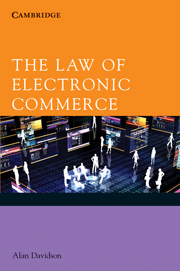Book contents
- Frontmatter
- Contents
- Acknowledgements
- Table of Cases
- Table of statutes
- 1 The law of electronic commerce
- 2 The rule of cyberspace
- 3 Electronic commerce and the law of contract
- 4 Shrinkwrap, clickwrap and browsewrap contracts
- 5 Electronic signatures
- 6 Copyright issues in electronic commerce
- 7 Electronic commerce – trade marks, patents and circuit layouts
- 8 Domain names
- 9 Domain name disputes
- 10 Uniform domain name dispute resolution policies
- 11 Jurisdiction in cyberspace
- 12 Defamation in cyberspace
- 13 Privacy and data protection in cyberspace
- 14 Electronic mail and online presence
- 15 National electronic surveillance
- 16 Cybercrime
- 17 Evidence of electronic records
- 18 Censorship – Broadcast and online content regulation
- 19 An international perspective
- Appendix A Electronic Transactions (Victoria) Act 2000
- Appendix B UNCITRAL Model Law on Electronic Commerce
- Appendix C Selected provisions Copyright Act 1968 (Cth)
- Appendix D ICANN Uniform Dispute Resolution Policy (UDRP)
- Appendix E .au Dispute Resolution Policy (auDRP)
- Appendix F National Privacy Principles
- Index
14 - Electronic mail and online presence
Published online by Cambridge University Press: 05 June 2012
- Frontmatter
- Contents
- Acknowledgements
- Table of Cases
- Table of statutes
- 1 The law of electronic commerce
- 2 The rule of cyberspace
- 3 Electronic commerce and the law of contract
- 4 Shrinkwrap, clickwrap and browsewrap contracts
- 5 Electronic signatures
- 6 Copyright issues in electronic commerce
- 7 Electronic commerce – trade marks, patents and circuit layouts
- 8 Domain names
- 9 Domain name disputes
- 10 Uniform domain name dispute resolution policies
- 11 Jurisdiction in cyberspace
- 12 Defamation in cyberspace
- 13 Privacy and data protection in cyberspace
- 14 Electronic mail and online presence
- 15 National electronic surveillance
- 16 Cybercrime
- 17 Evidence of electronic records
- 18 Censorship – Broadcast and online content regulation
- 19 An international perspective
- Appendix A Electronic Transactions (Victoria) Act 2000
- Appendix B UNCITRAL Model Law on Electronic Commerce
- Appendix C Selected provisions Copyright Act 1968 (Cth)
- Appendix D ICANN Uniform Dispute Resolution Policy (UDRP)
- Appendix E .au Dispute Resolution Policy (auDRP)
- Appendix F National Privacy Principles
- Index
Summary
The availability of electronic mail (email) goes beyond the introduction of postal systems, the telephone, telexes and facsimile. In the near future verbal communication will take place with greater ease and clarity than the telephone. Additionally, users will have the advantage of digitally saving conversations in a similar way to the way in which they can already save email messages. The tools to access and navigate between systems are steadily becoming cheaper, more powerful and easier to use. The internet provides tools to maximise the use of time to engage in discourse, study and recreation in a manner previously unimaginable. Email adds a further dimension to communication. Email will be required by many government departments and courts for the lodging of materials and to facilitate correspondence. Email is a fast and efficient worldwide communication portal. This chapter deals with legal and practical issues relating to the use of electronic mail and maintaining an online presence.
Email is one of the most popular applications of the internet. It allows users to send messages created on the computer to any other internet computer in a matter of seconds. Data files such as photographs, sound clips and, more usually, word-processed document files, can be attached to an email message. In fact any file which may be stored digitally may be transferred by email. It is usually cheaper and quicker than a telex or facsimile and more reliable than the ordinary post.
- Type
- Chapter
- Information
- The Law of Electronic Commerce , pp. 243 - 255Publisher: Cambridge University PressPrint publication year: 2009



